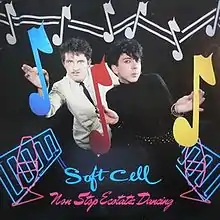Non Stop Ecstatic Dancing
Non Stop Ecstatic Dancing is an EP by English synthpop duo Soft Cell, released in the United Kingdom in June 1982 as a mini album by Some Bizzare Records. In addition to remixes of the group's older material, it also included a brand new track, a cover of Judy Street's 1966 song "What?", which was a Top 3 hit for Soft Cell.
| Non Stop Ecstatic Dancing | ||||
|---|---|---|---|---|
 | ||||
| EP by Soft Cell | ||||
| Released | June 1982 | |||
| Recorded | 1982 | |||
| Genre | Synthpop, new wave | |||
| Length | 27:50 | |||
| Label | Some Bizzare Sire Vertigo (original release) Mercury (various reissues) | |||
| Producer | Mike Thorne | |||
| Soft Cell chronology | ||||
| ||||
| Singles from Non-Stop Ecstatic Dancing | ||||
| ||||
As the name implies, Non Stop Ecstatic Dancing was conceived, by the band's own admission, under the influence of MDMA (commonly referred to as ecstasy). Vocalist Marc Almond later said in an interview with journalist Simon Tebbutt that the album's sound, as well as the sound of the band, was influenced by a short stint working at The Warehouse, a popular nightclub in Leeds. The album is more dance-oriented than the group's first album Non-Stop Erotic Cabaret, with remixes and instrumental versions of various songs from its predecessor as well as the new track 'What'. In the UK, this mini lp format was just becoming prominent. Subsequent reissues would see the original mini album length track listing bolstered with several extended versions of other Soft Cell material of the period.
Originally, the album was set to be produced by Donald Fagen of Steely Dan, and several tracks co-written by him were recorded, but those songs were shelved due to label disputes with MCA Records. The whole album had to be scrapped due to songwriting liabilities and Soft Cell famously had to write and record the album in the span of one week.
The band went on hiatus for a small period of time after the album's release, with David Ball taking time to reconcile with his girlfriend and Almond performing with Marc and the Mambas. This fuelled rumours that the band was splitting up, though they would release two more albums (1983's The Art of Falling Apart and 1984's This Last Night in Sodom).
Reception
| Review scores | |
|---|---|
| Source | Rating |
| AllMusic | |
| The Philadelphia Inquirer | |
| Smash Hits | |
From a contemporary review, Ken Tucker of The Philadelphia Inquirer gave the release a one star rating out of five, declaring it "more sterile English dance music" and that the release was "more of the same junk. And I do mean same: Two of the cuts here are simply re-recorded versions of previously released material."[4]
Track listing
All tracks are written by Dave Ball and Marc Almond, except where noted.
| No. | Title | Writer(s) | Length |
|---|---|---|---|
| 1. | "Memorabilia" | 5:22 | |
| 2. | "Where Did Our Love Go?" | Brian Holland, Lamont Dozier, Edward Holland Jr. | 4:12 |
| 3. | "What?" | H. B. Barnum | 4:33 |
| 4. | "A Man Could Get Lost" | 4:05 | |
| 5. | "Chips on My Shoulder" | 4:26 | |
| 6. | "Sex Dwarf" | 5:15 |
| No. | Title | Writer(s) | Length |
|---|---|---|---|
| 7. | "Tainted Love/Where Did Our Love Go?" (Extended) | Ed Cobb, Holland, Dozier, Holland | 8:57 |
| 8. | "Memorabilia" (Extended) | 7:45 | |
| 9. | "What?" (Extended) | Barnum | 6:11 |
| 10. | "...So" (Extended) | Ball | 8:50 |
| 11. | "Torch" (Extended) | 8:30 | |
| 12. | "Insecure...Me?" (Extended) | 8:15 |
| No. | Title | Writer(s) | Length |
|---|---|---|---|
| 1. | "Memorabilia" | 5:22 | |
| 2. | "Where Did Our Love Go?" | Holland, Dozier, Holland | 4:24 |
| 3. | "What?" | Barnum | 4:33 |
| 4. | "A Man Could Get Lost" | 3:58 | |
| 5. | "Insecure...Me?" | 7:30 | |
| 6. | "Sex Dwarf" | 5:15 |
Memorabilia appears here as a brand new version of the b-side of A Man Can Get Lost, sung in duet with Cindy Ecstasy.
Where Did Our Love Go is a remix of the b-side of Tainted Love.
A Man Could Get Lost and Chips On My Shoulder are heavily remixed instrumental versions of the original songs.
Sex Dwarf is also remixed, but is closer to the structure of the original song.
The original North American vinyl release replaced "Chips on My Shoulder" with an edit of the extended version of "Insecure...Me?", while the 1999 remastered CD reissue contained both tracks.
Personnel
|
|
Charts
Weekly charts
|
Certifications
|
References
- McDonald, Steven. "Non-Stop Ecstatic Dancing – Soft Cell – Review". Allmusic. Rovi Corporation. Retrieved 21 June 2006.
- Tucker, Ken (1 August 1982). "New Albums". The Philadelphia Inquirer. p. 8-H. Retrieved 26 May 2020.
- Silverton, Peter (24 June 1982). "Album Reviews)". Smash Hits. Vol. 4 no. 13. EMAP Metro. p. 17.
- "Soft Cell – Non-Stop Ecstatic Dancing" (in Dutch). MegaCharts. Hung Medien. Retrieved 25 July 2011.
- "The Official Charts Company – Soft Cell – Non Stop Ecstatic Dancing". Official Charts Company. Retrieved 25 July 2011.
- "Non-Stop Ecstatic Dancing – Soft Cell – Billboard Albums". Allmusic. Rovi Corporation. Retrieved 25 July 2011.
- "Certified Awards Search". British Phonographic Industry. 15 November 1982. Retrieved 25 July 2011.